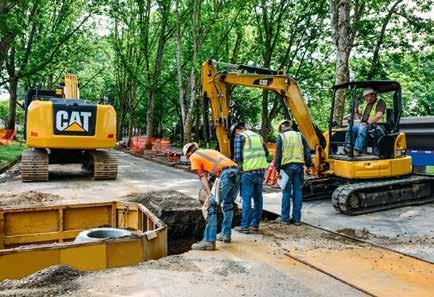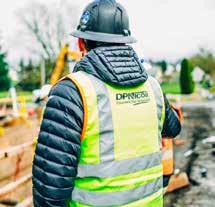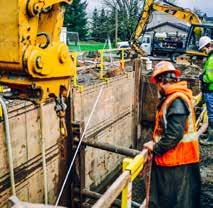
7 minute read
No End in Sight
Materials Cost and Supply Chain Issues: Some Improvement But No End in Sight
By Ken Simonson, Chief Economist, AGC of America
Contractors who feel they’ve been hit with never-ending cost increases and delivery delays since the beginning of the coronavirus pandemic are only partly right. Some of the price increases and shortages have eased. But others keep popping up, and more are likely to appear in the foreseeable future.
A long list of events contributed to price and supply problems. Even before widespread shutdowns hit U.S. mills and factories in March 2020, there were sudden shortages of materials from China and Italy, ranging from kitchen items to elevator parts.
By May of that year, demand for wood products was soaring, from homebuilders, remodelers, and restaurants that were adding decks and “streateries.” Meanwhile, lumber mills struggled to get back employees and truck drivers. Extreme weather, insect infestations, bordercrossing delays, and an increase in lumber tariffs all affected supplies and prices of timber and lumber from Canada. The result was an unprecedented runup in lumber prices.
Soon, steep increases in steel, copper, and aluminum prices followed. A surge in demand for consumer goods, many of them produced in China, Korea, and Southeast Asia, led to unheard-of delays at West Coast ports. A six-day blockage of the Suez Canal further discombobulated global shipping flows.
Explosive demand for warehouses and data centers overwhelmed structural steel producers, leading to long delays in deliveries of bar joists and contributing to a doubling of waiting times for switchgear and transformers.
A major freeze in Texas in February 2021 damaged most of the plants that produce a variety of construction plastics. The effects were felt throughout the nation for much of the year. Supplies plummeted and prices soared for PVC pipe, insulation and roofing materials, vapor barriers, geotextiles, acrylics and resins for paints and coatings, and more. A hurricane that cut electric power transmission to petrochemical plants in Louisiana in late August of 2021 added to the shortfalls of some plastic materials.
A shortage of computer chips began in early 2021 when a fire and, later, an earthquake damaged a plant in Japan that was a leading chip supplier to the motor vehicle industry. Chip shortages continue to hold down the supply of pickups and other work vehicles, as well as construction equipment and “smart” tools.
Russia’s attack on Ukraine in February 2022 disrupted supplies of numerous materials from Ukraine itself, ranging from steel to clay used by tile makers in Italy and Spain. Sanctions on Russia imposed by Western countries further constricted supplies.
The invasion and sanctions initially caused huge price spikes, notably for crude oil. Consequently, gasoline and diesel fuel prices soared to record highs. But they have also slowed economic activity. The slowing, along with the resumption of some shipments that had been cut off, has brought some prices back below pre-war levels.
China has tried to prevent the spread of coronavirus by engaging in drastic
lockdowns, most notably for more than two months in the spring of 2022 in Shanghai. This action cut production and shipping of some goods to the U.S.
By August 2022, power generation, manufacturing, and barge traffic were being disrupted by extreme heat and drought in China and Western Europe. Drastically reduced flows of natural gas from Russia to European countries in retaliation for Western sanctions drove prices of natural gas to record highs there, forcing some factories that use it for fuel or feedstock to close.
In short, a wide variety of largely unforeseeable events has made prices and supplies extremely volatile. The chart below shows the impact these diverse events have had on prices for seven major categories of inputs to construction. Some of the categories are very broad; for instance, steel mill products include steel used in automotive, appliance, and other applications, as well as structural, plate, rebar, fasteners and other construction steel products. Similarly, copper and brass mill shapes, aluminum mill shapes, and truck transportation of freight encompass products or services used in a number of sectors. Other categories, such as plastic construction products and gypsum building materials, are used almost exclusively in construction. Lumber and plywood are used predominantly in construction but also in manufacturing.
Each colored line traces the change in the producer price index (PPI) for a category, as calculated by the Bureau of Labor Statistics. Each month, BLS asks thousands of producers—manufacturers, wholesalers, retailers, and providers of services such as trucking and design services—what they charged on the 11th day of the previous month for a specific item. BLS then aggregates those prices and turns them into an index number for a category, such as steel mill products. The mix of items in a category remains fixed. The index number itself is meaningless but the change from one period to another measures the amount of price increase or decrease that occurred. Committed to Safety, Quality Assurance, Customer Service, Integrity, Partnering & Team Participation
Services/Capabilities
• Large or Small Commercial, Residential or Government Projects • Installation of Underground Sewer, Water, Pressurized Irrigation,
Storm Drain & Gravity Irrigation Utilities • Clearing & Grubbing • Mass Excavation & Grading • Excavation of Concrete Foundations & Prep Building Pads • Concrete Prep & Concrete • Asphalt Prep and Paving • Site Restoration
Taylor Landa (208) 800-8151 tlanda@centralcovellc.com Dusty Painter (208) 817-1607 dpainter@centralcovellc.com


COMMERCIAL & INDUSTRIAL HVAC COMPANY 40 years serving the Treasure Valley
• Roof top units • Split systems • Spec & design build • Chillers • Controls • Duct manufacturing • Custom design projects • Commercial new construction
24/7 SERVICE DEPARTMENT • Preventive maintenance • Planned unit replacements • Facility audits
CELEBRATING
IN BUSINESS
TML Commercial Services
120 EAST 40TH STREET, BOISE, ID 83714 208-515-3380
tmlcommercialservices@serviceexperts.com www.tmlcommercialservices.com
The starting point for this chart is April 2020, when demand for many items had tumbled, it appeared the economy might be heading into a deep, long recession, and prices hit bottom. As it turned out, some activities—such as construction and remodeling of houses, warehouses, and data centers—took off, while production and distribution were crimped, and prices of all of the items soared for the next year or so.
Since the spring of 2021, the picture has been much more jumbled. Production caught up with demand for some products, such as lumber. And the semiconductor chip shortage curbed automakers’ demand for steel, aluminum, and copper, bringing those prices down at least temporarily. However, all of the lines remain substantially higher than in April 2020.
There is one other line on the chart. It traces the price that contractors tell BLS they would charge to erect a fixed set of nonresidential buildings. Each contractor is asked about the same building it was asked about before. This process probably comes as close as possible to the usual method of asking a producer the price it actually charged for a particular item.
This “bid price” index (the formal name is the PPI for new nonresidential building construction) covers warehouse, school, office, industrial, and health care buildings. The index rose very moderately for the first year shown in the chart. It has risen more steeply in 2022 as contractors have passed along more of their costs and become more selective in bidding. But the cumulative change in bid prices is still far short of the increase since April 2020 in prices for any of the major inputs.
Going forward, it appears prices will remain volatile. A slowing economy in the U.S. and worldwide will exert downward pressure. But unpredictable events—war, extreme weather, possible strikes of rail or port workers, to mention just a few possibilities—can cause sudden price spikes and sometimes long supplychain disruptions.
Contractors can’t guard against all of these occurrences. But they must stay in close touch with suppliers and information providers. They need to communicate any change in costs, schedules, and possible alternatives with owners. They can explore using price adjustment clauses in contracts, purchasing or order some items much earlier than in the past, and hedging or otherwise seeking price protection or risk-sharing. l













